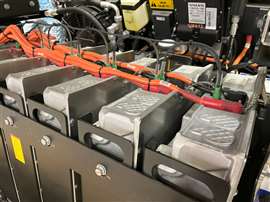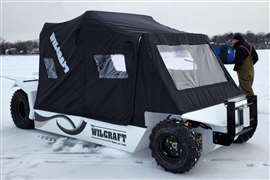Read this article in 中文 Français Deutsch Italiano Português Español
2025 forecast: electrification in key segments to reach 24.5% by 2029
22 December 2024
What has happened since 2020 and what is expected in key off-highway segments through 2029.
In the five years or so preceding the Inflation Reduction Act of 2022 (IRA), the growth in electric-powered equipment in North America was mostly limited to forklift trucks, some smaller lawn and garden equipment and passenger cars. While it should be noted that passenger cars are outside the scope of this article, the impact and changes in that segment (led by companies such as Tesla) have bled into the agriculture, construction, industrial and lawn and garden segments.
 Electric-powered equipment is expected to grow an average of 16.6% per year through 2029, growing from 900,000 to 3.6 million units. (Photo: Becky Schultz)
Electric-powered equipment is expected to grow an average of 16.6% per year through 2029, growing from 900,000 to 3.6 million units. (Photo: Becky Schultz)
In fact, from 2020 to 2029, Power Systems Research (PSR) expects the electric-powered equipment market to grow by a massive 296% (see Figure 1) and this growth rate is only exceeded by hybrids, which is expected to grow by 327%. However, in these segments hybrid volumes are very low, so that impressive growth figure does not amount to any real significant volume.
The growth of electric-powered equipment is expected to be an average of 16.6% per year out to 2029 and growing in unit terms from 900,000 to 3.6 million units. Internal combustion engines, on the other hand, will only manage to grow a paltry 0.3% per year on average – growing from 11.6 million in 2020 to 11.9 million units by 2029.
As the whole market (for these segments) is expected to grow from 12.6 million units in 2020 to 15.7 million units in 2029, it means that the percentage of the market that is electrified (battery electric and corded electric) will grow from 8.7% in 2020 to 24.5% in 2029 (see Figure 2).
It should be noted that in these segments, fuel cell vehicles are insignificant in both volume and statistical terms.
Industry segments
Agriculture and construction are, in volume terms, a very small part of the electric market with under 500 units in 2020, and this is expected to increase to only 20,000 units by 2029.
Agricultural equipment is not expected to grow much, as the segment is dominated by tractors which at this stage do not have the ability to work the full duty cycles that harvest time on farms require; as such, many farmers are unwilling to spend the necessary capital to go electric. Alternative fuels such as biofuels and methane are more likely routes for farmers who wish to “go green,” but there are only a few suitable machine models currently available.
The industrial segment contains a large number of diverse electrified products, and these are expected to grow from 370,000 in 2020 to 1.1 million by 2029, with all equipment growing well. Pressure washers provide the largest growth (from 140,000 to 550,000), with growth driven by several factors, not the least of which is cost, which now favors electrified products in this segment.
The lawn and garden segment provides the greatest volume growth of all these segments – it’s expected to climb from 580,000 units in 2020 to a massive 2.6 million units by 2029. This growth will be led by chainsaws, mowers and leaf blowers, supported by state and local regulations against noise and pollution from older two-stroke engine designs.
Meanwhile, all this growth has been supported by the IRA and the billions of dollars invested in domestic energy production as well as the promotion of clean energy.
Batteries and New Battery Plants
One of the outcomes of the IRA has been the significant investment into research and development of new battery technologies and the construction of new battery plants in North America.
 Significant investment has been made in battery technology R&D and in construction of new battery plants in North America. (Photo: Becky Schultz)
Significant investment has been made in battery technology R&D and in construction of new battery plants in North America. (Photo: Becky Schultz)
Currently, most battery packs in electrical equipment are lithium-ion batteries or, to be more specific, NMC lithium batteries, which means they have a cathode containing a mix of nickel, manganese and cobalt. The direction of battery research over the last few years has moved to all sorts of battery chemistries (lithium ferrous phosphate, lithium sulphur and sodium air, to name just a few), but possibly the most important of these is solid-state batteries.
Solid-state batteries are significantly lighter, safer and more energy dense than current batteries. After significant research and development, they are beginning to arrive, with several major car companies planning their introduction over the next five years. These will eventually work their way into off-road machinery and will provide another spark for growth in these segments.
By 2025, the IRA will have supported the introduction of nine new battery production plants in North America with a capacity of 257 GWh. The plants will provide batteries for all applications (most of the plants are automotive related), and this investment should lower battery prices. These factories are either completed or nearly so, but there are an additional nine plants (or more) with a massive 486 GWh capacity that may come online before 2030.
All the volume changes mentioned at the beginning of this article are driven by battery prices, battery capacity and what is going on in the automotive world. Recent research (by Goldman Sachs) suggests that battery prices, which were heading towards US$100 per kWh, may reach US$80 per kWh as soon as 2026.
However, recent changes in the U.S. political map mean that these unit volumes and the battery plant capacities are no longer certain.
Impact of Trump Administration
The incoming administration will have a significant impact on electrification in North America. The IRA has spurred a clean energy boom, but it will be challenged under the Trump administration.
Given that Republican states have received 80% of the IRA’s money, with which they have built factories and created thousands of jobs, a complete IRA repeal is unlikely. What’s more probable is that we may see a phase-out of tax credits earlier than planned or new caps on overall funding. The administration could defund or limit some of the electric vehicle (EV) subsidies included in the IRA through enacting new executive orders.
 About the Author: Power Systems Research (PSR) is a supplier of global production data and forecasts to the engine, power products and components industries. As forecast and technology adoption lead, Guy Youngs is responsible for PSR’s industry forecast and overseeing the rate of technology adoption of alternative power sources into the future outlook and technology mix.
About the Author: Power Systems Research (PSR) is a supplier of global production data and forecasts to the engine, power products and components industries. As forecast and technology adoption lead, Guy Youngs is responsible for PSR’s industry forecast and overseeing the rate of technology adoption of alternative power sources into the future outlook and technology mix.
However, the clean energy market is not solely driven by federal policy. State policies play a huge role, too, and many states are committed to their own clean energy goals. States like California, New York and Washington have ambitious targets to combat climate change, and traditionally Republican-based Texas is No. 1 in the U.S. for both solar and wind.
Corporations are also key players. Companies such as Amazon, Google and Walmart have committed to going 100% renewable, and they are not about to reverse course. This demand keeps the market for renewables strong. Plus, there is significant public support for clean energy jobs, and renewables create more employment opportunities than fossil fuels in many regions of the country.
While a lot of this movement is potentially going to hit industries such as automotive, it must be remembered that where the automotive industry leads, others follow. So sooner or later, these changes may impact the industrial, lawn and garden, construction and agricultural segments.
A slowing of electrification is likely under the Trump administration, but it is also very risky. For the sake of comparison, we can look at the adoption rates of EVs in the passenger cars segment in some other countries.
In the UK, for example, EV adoption for passenger cars is already at 30% and in China it is over 50%. The U.S. is forecast to reach 28% EV adoption in passenger cars by 2030. If the U.S. slows the electrification drive, then it might find itself lagging even more behind the rest of the world, losing research and development opportunities and missing out on thousands of jobs.
Editor’s note: this article originally appeared in the December 2024 issue of Power Progress.
POWER SOURCING GUIDE
The trusted reference and buyer’s guide for 83 years
The original “desktop search engine,” guiding nearly 10,000 users in more than 90 countries it is the primary reference for specifications and details on all the components that go into engine systems.
Visit Now
STAY CONNECTED




Receive the information you need when you need it through our world-leading magazines, newsletters and daily briefings.
CONNECT WITH THE TEAM













